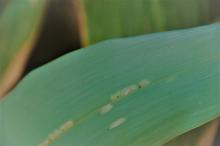Stigmeopsis (Schizotetranychus) celarius, Stigmeopsis longus
See:
Pest description and crop damage Bamboo mites have a flattened body, which is straw-colored to greenish yellow with small blackish green spots. First impression is that leaves are under attack by a leafminer. The mite feeding on the plant cell contents leaves a distinct pattern of damage visible on both sides of the leaf. The feeding site damage is yellow and may look similar to variegation. Preferred bamboo hosts for this mite include the genera Sasa, Indocalamus, Phyllostachys, and Pleioblastus.
Biology and life history These mites form colonies on the underside of the leaves and live under a densely woven web. Generally the mites remain under the web to feed and lay eggs, leaving to defecate in black fecal piles slighted removed from the nest. Adults and nymphs can sometimes be found outside the webbing, particularly as they begin to form new nests. Multiple males and females can be found in the web nests and often many webbed nests will form alongside each other running down the underside of the bamboo leaves. There are many generations per year for S. celarius.
Management-biological control
The predator mite Neoseiulus fallacis has been used successfully to control bamboo mite. The keys to the successful use of this mite are good scouting and releasing the mite at the proper threshold. Releases are more effective at low populations of the spider mite. These low levels of pests are not usually noticed without a rigorous scouting program. This particular predator mite requires 80% humidity, easily found in the canopy of bamboo grown in the Northwest. N. californicus may work in dryer conditions.
Management-cultural control
Bamboo mites only feed on bamboo and infestations can be avoided by screening all new material for the mites. Quarantine all new material to avoid spread of bamboo mites to existing bamboo nursery stock. Severe infestations can be treated by cutting down all cane growth on infested plants and burning or otherwise disposing of the foliage. The remaining foliage then can be treated more effectively for mites. Although severe, this treatment may be the only practical solution for heavily infested sites, particularly where chemical application presents difficulties.
USDA Agriculture Handbook 193 mentions the use of hot water treatment for dormant rhizomes to eliminate mites. It suggests immersing them for 10 minutes in hot water at 50ºC (122ºF), then heeling into sand or sawdust and keeping them cool until planting time in the spring.
Management-chemical control
See:
Chemical Control of Nursery Pests
The nature of the webbing and protection it gives mites suggests the need for power equipment so that material can reach mites under webbing. Add a spreading surfactant, recommended by some labels (including bifenazate), because bamboo leaves are difficult to wet.
For more information
Johnson, W.T. and H.H. Lyon (1991), Insects That Feed on Trees and Shrubs, 2nd ed., Cornell University Press (p. 474).
PNW Nursery IPM website: Bamboo Mite IPM (https://agsci.oregonstate.edu/nurspest/mites/bamboo-mite)



